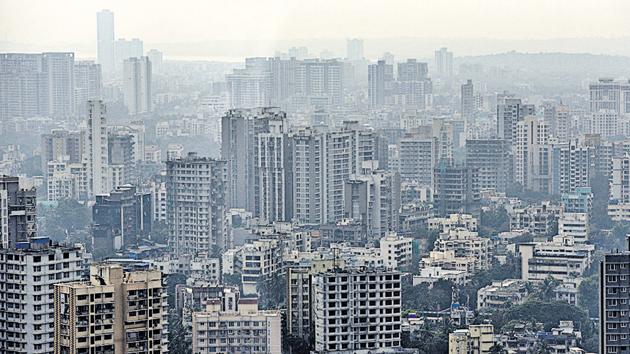Mumbai’s winter pollution more toxic in 2020; PM2.5 levels 25-30% higher than 2019: CSE
The average share of tiny pollutant particles that can easily enter the lungs and cause health ailments — PM2.5 — was higher across all cities in Maharashtra this winter with the maximum spike observed in Mumbai.

This winter, air pollution set in almost two weeks earlier, indicating a change in pattern. The average PM2.5 levels were 25-30% higher in October and November for the Mumbai region compared to the same period last year.
An analysis of winter pollution (till the first week of December 2020) in major cities of Maharashtra was carried out by the Delhi-based Centre for Science and Environment (CSE), Delhi. Released on Friday, CSE’s analysis revealed that the clean air gains of the early months of lockdown and monsoon were offset by the reopening of the economy and winter weather.
The share of PM2.5 in PM10 (larger coarser particles) this winter was 40% during October and 46% through November. It is generally lowest during summer and monsoon months (less than 30%) and highest on Diwali.
“The share of tinier and finer particles (PM2.5) in the overall coarser PM10 concentration determines the toxicity of air. When the overall share of tinier PM2.5 in the overall coarser PM10 is higher, the air is more toxic as the tiny particles penetrate deep inside the lungs and cut through the blood barrier increasing the health risk,” said CSE in its analysis.
As compared to the cleanest air quality week this year (in the week ending on July 5) for Mumbai, the weekly average increased 10 times during the week ending on November 15.
Anumita Roy Chowdhury, executive director-research and advocacy, CSE said, “Pollution levels increased during winter despite the geographical advantages and favourable meteorology for Mumbai. This indicates high local pollution and strong regional influences.”
According to the analysis, overall average PM2.5 levels for just over 11 months (January to December first week) were considerably lower than those of 2019 due to the impact of the lockdown. However, PM2.5 concentration during winter rose beyond safe standards for Mumbai and the rest of Maharashtra. October saw more polluted air across all cities, and Mumbai was the worst as its average PM2.5 levels were 25% higher than in 2019. It was 26% higher for Navi Mumbai and 28% higher in Kalyan. November was also more polluted with the monthly average being 7% higher in Mumbai, 21% in Navi Mumbai, and 31% in Kalyan. Cities outside the Mumbai Metropolitan Region also showed a similar or marginally lower trend.
Chowdhury explained that thanks to better ventilation through the se brrese, suspension of pollutant particles was much was much lower in Mumbai than in the Indo-Gangetic plain in winter. However, pollution sources from vehicles, industry, construction, and biomass burning had helped bring winter pollution in almost two weeks earlier. “Reopening of the economy coinciding with the onset of winter allow PM2.5 levels to rise starting from October. It is clear that the Mumbai region cannot rely only on its locational advantage of proximity to the sea,” she said.
So far, the most polluted areas in Mumbai include Worli, Vile Parle, Kurla and the Chhatrapati Shivaji Maharaj International Airport (CSIA) where the 24-hour PM2.5 average was in the ‘very poor’ category on multiple days during November even as the city-wide average was in the ‘moderate’ category.
Among solutions, CSE suggested strict enforcement of power plant standards across Maharashtra; minimise use of coal and other dirty fuels in the industry; improving emissions control; scale up public transport and vehicle restraint measures; and manage waste through zero waste and zero landfill strategy. “There is a need for deep cuts across all key sectors of pollution and across the entire region to reduce annual average levels and thereby avoid winter pollution peaks for Maharashtra cities,” said Chowdhury.
WARNING FOR FURTHER POLLUTION SPIKE DURING CHRISTMAS, NEW YEAR: CSE
Air quality in the city is usually at its worst around Christmas and New Year. Going by this trend, a further spike in air pollution may be expected said CSE. Kurla and Worli have the highest November averages in Mumbai, while Bandra, CSIA and Colaba have the lowest. Nerul in Navi Mumbai is the most polluted in the Greater Mumbai region. CSIA, despite one of the lowest monthly concentrations, has the highest daily spikes.
CSE STUDY SHOWS DIWALI AIR WAS MORE POLLUTED THAN 2019
The average PM2.5 level on Diwali day (November 14) in Mumbai was 76 micrograms per cubic metre (μg/m3), up from 53 μg/m3 recorded in 2019. There was a 75% higher rise in hourly PM2.5 concentration between afternoon and night of Diwali 2020 mostly due to firecracker bursting. The change in hourly PM2.5 concentration between afternoon and night of 2020 Diwali was 145 μg/m3, up from 83 μg/m3 in 2019. Diwali also occurred later in November than the previous year (October 27).
HOW THE ANALYSIS WAS DONE?
CSE did its analysis based on air quality data from 10 monitoring stations in Mumbai; three in Navi Mumbai; two in Chandrapur; and one station each in Thane, Kalyan, Pune, Nagpur, Nashik, Aurangabad, and Solapur under the continuous ambient air quality monitoring system (CAAQMS) of the Central Pollution Control Board. This data is publicly available real time information from CPCB’s official online portal, Central Control Room for Air Quality Management.



